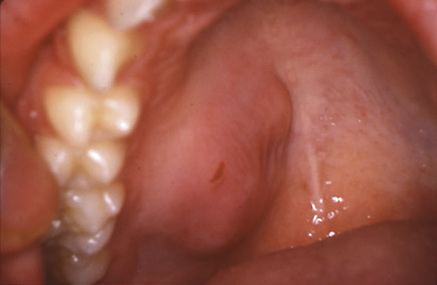Lumps and swellings
INTRODUCTION
Many different conditions may present as oral lumps or swellings, causes including the following:
 The mouth’s normal anatomy, such as tongue foliate or circumvallate papillae (Figs 10.1 and 10.2).
The mouth’s normal anatomy, such as tongue foliate or circumvallate papillae (Figs 10.1 and 10.2).
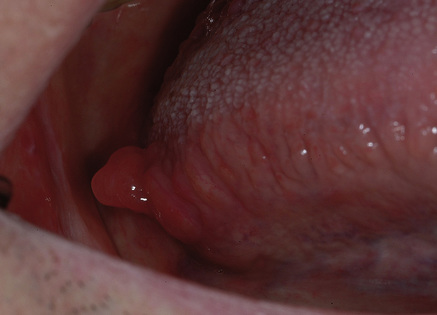
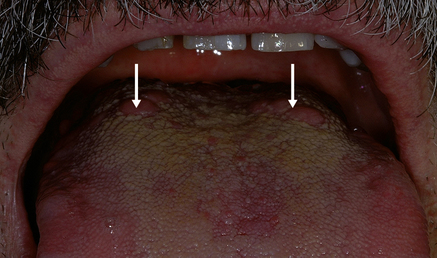
 Developmental lumps: unerupted teeth, and tori are common causes of hard swellings related to the jaws. Cysts and hamartomas may present as a swelling. Hamartomas include lymphangiomas and haemangiomas (angiomas). Lymphangiomas are hamartomas or benign neoplasms of lymphatic channels that present as a colourless, sometimes finely nodular soft mass. Bleeding into lymphatic spaces causes sudden purplish discolouration. If in the tongue and extensive, it is a rare cause of macroglossia. If in the lip, it is a rare cause of macrocheilia. Diagnosis can be confirmed, if necessary, by excision biopsy.
Developmental lumps: unerupted teeth, and tori are common causes of hard swellings related to the jaws. Cysts and hamartomas may present as a swelling. Hamartomas include lymphangiomas and haemangiomas (angiomas). Lymphangiomas are hamartomas or benign neoplasms of lymphatic channels that present as a colourless, sometimes finely nodular soft mass. Bleeding into lymphatic spaces causes sudden purplish discolouration. If in the tongue and extensive, it is a rare cause of macroglossia. If in the lip, it is a rare cause of macrocheilia. Diagnosis can be confirmed, if necessary, by excision biopsy.
Haemangiomas are vascular malformations that are red, purple or blue, painless, soft and sometimes fluctuant and usually blanch on pressure. Most appear in infancy, but about 15% develop later. Haemangiomas are common on the tongue, lip vermilion, or buccal mucosa. Diagnosis may be assisted by aspiration, ultrasonography, radiography, angiography, MRI, and MRI-angiography. Differentiation is from lymphangioma, telangiectasia, purpura, Kaposi sarcoma and epithelioid angiomatosis. Management may be active, with removal of the haemangioma, or simple observation (since some 50% regress spontaneously in childhood). Cryosurgery or laser (Nd-YAG, carbon dioxide, pulsed tuneable dye or copper vapour) are the main treatments. Alternatively, sclerosant injection (boiling water, absolute alcohol, sodium tetradecyl sulphate, sodium morrhuate, or ethanolamine oleate (or propranolol)), compression sutures (Popescu) or (rarely) arterial embolization are used.
 Inflammatory lumps: dental abscess is one of the most common causes of oral swelling. Parasites are rare. Non-infective inflammatory causes include fibrous lumps, Crohn disease, orofacial granulomatosis and sarcoidosis. Salivary gland inflammation can cause swelling in sialadenitis.
Inflammatory lumps: dental abscess is one of the most common causes of oral swelling. Parasites are rare. Non-infective inflammatory causes include fibrous lumps, Crohn disease, orofacial granulomatosis and sarcoidosis. Salivary gland inflammation can cause swelling in sialadenitis.
 Fibrous lump or nodule (‘fibroepithelial polyp’): this is a pedunculated or broadly sessile, sometimes ulcerated, firm or soft, lump seen mainly on the buccal mucosa usually with a normal overlying mucosa. It is termed ‘epulis’ if on the gingival margin. It is common and is probably caused by chronic irritation causing fibrous hyperplasia. Excision biopsy helps differentiate it from any other soft tissue tumour. The flange of a denture impinging on the vestibular mucosa may stimulate a similar reactive hyperplasia – the so-called denture granuloma or denture-induced hyperplasia (denture granuloma; epulis fissuratum). This is a painless, firm swelling with a smooth pink surface usually in the buccal sulcus related to an ill-fitting lower complete denture, especially anteriorly lying parallel with the alveolar ridge and sometimes grooved or ulcerated by the denture flange. Several leaflets with a fairly firm consistency may develop. Common, mainly in middle-aged or older patients, the diagnosis is clear-cut if the lesion is in relation to a denture flange. If ulcerated, it may mimic carcinoma (rarely). Diagnosis is clinical, but excision biopsy may be indicated. The denture flange should be relieved, to prevent recurrence.
Fibrous lump or nodule (‘fibroepithelial polyp’): this is a pedunculated or broadly sessile, sometimes ulcerated, firm or soft, lump seen mainly on the buccal mucosa usually with a normal overlying mucosa. It is termed ‘epulis’ if on the gingival margin. It is common and is probably caused by chronic irritation causing fibrous hyperplasia. Excision biopsy helps differentiate it from any other soft tissue tumour. The flange of a denture impinging on the vestibular mucosa may stimulate a similar reactive hyperplasia – the so-called denture granuloma or denture-induced hyperplasia (denture granuloma; epulis fissuratum). This is a painless, firm swelling with a smooth pink surface usually in the buccal sulcus related to an ill-fitting lower complete denture, especially anteriorly lying parallel with the alveolar ridge and sometimes grooved or ulcerated by the denture flange. Several leaflets with a fairly firm consistency may develop. Common, mainly in middle-aged or older patients, the diagnosis is clear-cut if the lesion is in relation to a denture flange. If ulcerated, it may mimic carcinoma (rarely). Diagnosis is clinical, but excision biopsy may be indicated. The denture flange should be relieved, to prevent recurrence.
 Allergic: angioedema can produce diffuse swelling, typically of rapid onset. Oedema of slower onset may be orofacial granulomatosis.
Allergic: angioedema can produce diffuse swelling, typically of rapid onset. Oedema of slower onset may be orofacial granulomatosis.
 Traumatic: haematoma may cause a swelling at the site.
Traumatic: haematoma may cause a swelling at the site.
 Hormonal: pregnancy may result in generalized gingival swelling (pregnancy gingivitis) or a discrete lump (pregnancy epulis – really a pyogenic granuloma). Diabetes predisposes to periodontal abscesses and occasionally giant cell lesions are seen in hyperparathyroidism. Sialosis is a painless swelling of major salivary glands that often has a hormonal basis, for example in diabetes.
Hormonal: pregnancy may result in generalized gingival swelling (pregnancy gingivitis) or a discrete lump (pregnancy epulis – really a pyogenic granuloma). Diabetes predisposes to periodontal abscesses and occasionally giant cell lesions are seen in hyperparathyroidism. Sialosis is a painless swelling of major salivary glands that often has a hormonal basis, for example in diabetes.
 Drug induced: a range of drugs can produce gingival swelling – most commonly implicated are phenytoin, ciclosporin and calcium channel blockers. Drugs, such as chlorhexidine occasionally cause salivary gland swelling.
Drug induced: a range of drugs can produce gingival swelling – most commonly implicated are phenytoin, ciclosporin and calcium channel blockers. Drugs, such as chlorhexidine occasionally cause salivary gland swelling.
 Benign neoplasms, such as fibromas or salivary gland tumours may be seen. Malignant neoplasms may include carcinoma (Fig. 10.3), lymphoma, Kaposi sarcoma, malignant salivary gland tumours and others (Fig. 10.4). Occasionally metastatic malignant disease or leukaemia may present as a lump.
Benign neoplasms, such as fibromas or salivary gland tumours may be seen. Malignant neoplasms may include carcinoma (Fig. 10.3), lymphoma, Kaposi sarcoma, malignant salivary gland tumours and others (Fig. 10.4). Occasionally metastatic malignant disease or leukaemia may present as a lump.
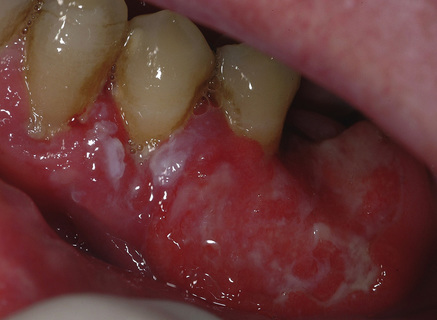
 Viral lesions: mumps virus can cause acute sialadenitis. Papillomas (Fig. 10.5), common warts (verruca vulgaris), genital warts (condyloma acuminatum) and focal epithelial hyperplasia (Heck disease) are all caused by human papilloma viruses (HPV). A higher prevalence is seen in patients with sexually shared infections or in people who are immunocompromised, as in HIV/AIDS. Papillomas are uncommon in the mouth, but typically seen on the fauces, soft palate or tongue, usually < 5 mm diameter and with whitish filiform projections. Warts are rare in the mouth: verrucae vulgaris are usually transmitted from skin lesions, and found predominantly on the lips whereas condyloma acuminata, transmitted from genital or anal lesions, are found mainly on the tongue or palate. Diagnose by biopsy to differentiate from other tumours and manage with podophyllum or imiquimod, excision, laser, or electro- or cryosurgery.
Viral lesions: mumps virus can cause acute sialadenitis. Papillomas (Fig. 10.5), common warts (verruca vulgaris), genital warts (condyloma acuminatum) and focal epithelial hyperplasia (Heck disease) are all caused by human papilloma viruses (HPV). A higher prevalence is seen in patients with sexually shared infections or in people who are immunocompromised, as in HIV/AIDS. Papillomas are uncommon in the mouth, but typically seen on the fauces, soft palate or tongue, usually < 5 mm diameter and with whitish filiform projections. Warts are rare in the mouth: verrucae vulgaris are usually transmitted from skin lesions, and found predominantly on the lips whereas condyloma acuminata, transmitted from genital or anal lesions, are found mainly on the tongue or palate. Diagnose by biopsy to differentiate from other tumours and manage with podophyllum or imiquimod, excision, laser, or electro- or cryosurgery.
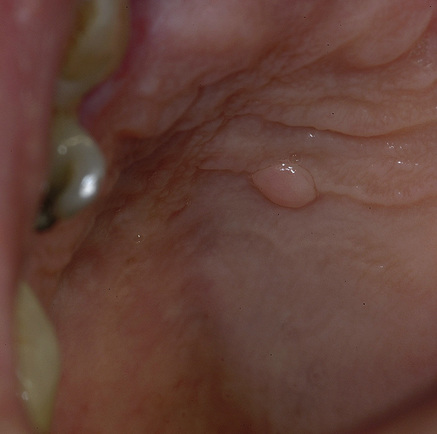
Stay updated, free dental videos. Join our Telegram channel

VIDEdental - Online dental courses


